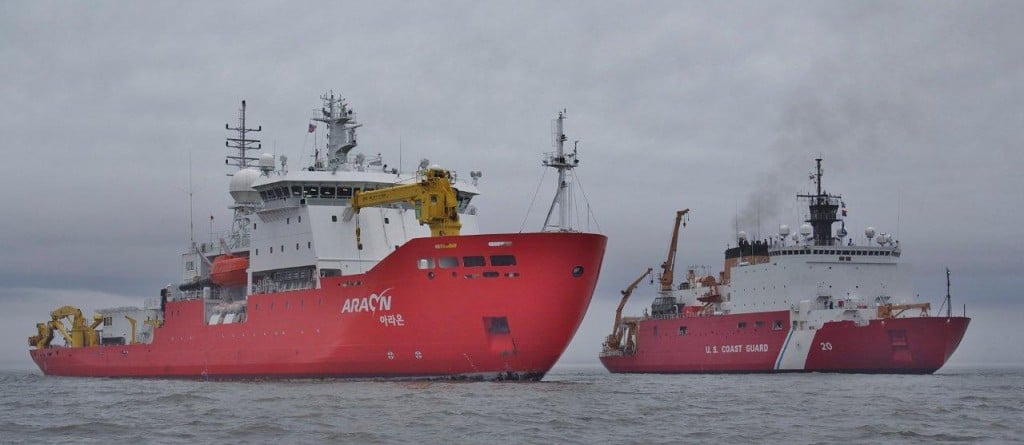
R/V Araon and USCGC Healy off Alaska in August 2013.
Four months after its acceptance as an observer to the Arctic Council, South Korea is fulfilling expectations surrounding its new role by leading a research survey into the Beaufort Sea to look for subsea permafrost and methane hydrates. The East Asian country’s self-constructed icebreaker, the Araon, left Barrow, Alaska on September 8 bound for Canadian waters. The Araon will spend a maximum of twenty days in Canada’s exclusive economic zone (EEZ), within the boundaries of the Inuvialuit Settlement Region (ISR), conducting its research. Seismic data will be collected with an array of eight airguns and ten ocean bottom seismometers.
The project is called the Canada-Korea-USA Beaufort Sea Geoscience Research Survey. Its leaders are scientists from Natural Resources Canada (NRCAN), Korea Polar Research Institute (KOPRI), and the U.S. Geological Survey (USGS). In terms of infrastructure provided, however, South Korea might actually warrant top billing. On an expedition to Antarctica this past spring, glaciologist Ted Scambos reported that the Araon’s announcer called the vessel “the ship of dreams for polar research.” Scambos agreed with this description. Neither Canada nor the U.S. have ships that can quite compare with the state-of-the-art Korean icebreaker, built in 2009. Scientists were involved in the construction of the Araon from its inception, so it is “so it is very well-equipped for science, with all the latest high-tech equipment, as well as dry and wet laboratories,” according to Dong Min Jin, KOPRI’s director. During its expedition in the Beaufort Sea, the Araon will also have an AS-350 helicopter onboard to help transport researchers carrying out separate projects on marine mammals and sea ice.
This latest expedition is a prime example of South Korea’s prowess in Arctic research. The country has the funds to carry out polar science, and, thanks to its world-class shipbuilding industry, it also has the necessary infrastructure. China, by contrast, has not yet mastered the art of ice-class shipping technology. The country’s sole icebreaker was purchased from Ukraine (though it is in the process of building a new icebreaker from scratch). South Korea and Japan are the only two Asian countries to have developed their own icebreakers. Japan’s polar research program is older than South Korea’s, and explorer Nobu Shirase even led a Japanese Antarctic expedition in 1910-1912. But South Korea is now the country making headlines in Asian-led polar research, bringing foreign scientists on board its vessel, too.
Notably, South Korean researchers recently teamed up with German scientists from the Alfred Wegener Institute. Together, they discovered never-before-seen traces of ice sheets on the East Siberian seafloor – research that was published online by Nature Geoscience this past August. A picture taken from this groundbreaking expedition graces the cover of this month’s Nature Geoscience. Dr. Nam Seung-il, a scientist at KOPRI, said to Yonhap (in Korean), “This amounts to Nature acknowledging the advances made in joint research efforts by Germany and South Korea, an underdog in Arctic exploration.”

Nature Geoscience cover, Oct. 2013. (c) Nature Geoscience.
South Korea’s interests in Arctic hydrocarbons have propelled it to new frontiers in polar research as well. In winter 2011, Korea Gas Corporation (KOGAS) sent a delegation to the Northwest Territories to consider constructing a liquefied natural gas (LNG) terminal for export to Asia. Now, the country has returned to the NWT, this time looking for methane hydrates at sea.

Map of Gas Hydrate Projects Worldwide
Methane, or gas, hydrates have been recognized as a possible source of new energy since at least the 1950s, when research into their potential really began. Several studies have taken place off the coasts of Alaska and Canada. Canada’s Beaufort Sea is familiar stomping ground for scientists looking for methane hydrates. It was here that the first demonstration was made of natural gas recovery from hydrates. By comparison, oil-rich Russia has very few, although a vast amount of the resource is believed to lie off East Siberia’s coast. Despite decades of research, methane hydrates are still a fairly unknown entity. For starters, it’s unclear what the potential environmental ramifications of developing this resource are, especially since methane is a potent greenhouse gas. Extraction could also destabilize the sea floor.
One thing is clear, though: South Korea is here to stay when it comes to polar research – even in other countries’ EEZs.